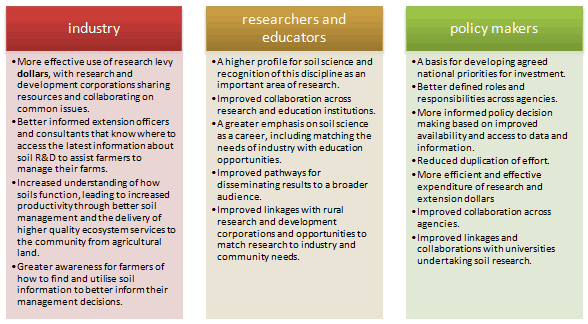For the first time Australia has a national, coordinated and forward thinking approach to managing our soil.
The National Soil Research, Development and Extension Strategy - 'Securing Australia’s soil for profitable industries and healthy landscapes' (soil RD&E strategy) will ensure soils research becomes more targeted and collaborative and that research will better meet the needs of farmers. There will also be better information and tools available on soil use and management.
The soil RD&E strategy:
- provides an overview of soil RD&E in Australia, including challenges and drivers for soil RD&E
- considers current investment and capability in soil RD&E
- presents a future RD&E plan, including goals and strategic directions
- considers roles and responsibilities and co-investment
- provides a set of implementation actions.
The Minister for Agriculture, the Hon. Barnaby Joyce, released the soil RD&E strategy in March 2014.
[collapse all]
What are the goals of the strategy?
The soil RD&E strategy goals include:
- improved co-investment
- improved access to quality soil data and information
- improved communication and sharing of soil knowledge
- adopting of a national approach to building future skills and capacity
- collaboration on the development and use of physical infrastructure such as laboratories, equipment, long-term field sites and soil archives.
Supporting these goals are a set of soil research and development strategic directions that will consider:
- how to improve soil management to increase productivity and profitability
- how to improve the mapping, modelling, monitoring and forecasting of soil-related issues
- finding ways to manage soil and sub-soil constraints
- improving our understanding of soil’s role in delivering ecosystem services
- determining how soil can be better managed across the landscape to deliver outcomes for farmers and the broader community.
For more detailed information about the goals and the anticipated outcomes of the strategy please read the summary.
How was the strategy developed?
The soil RD&E strategy was developed in collaboration with Australian, state and territory governments; CSIRO; rural research and development corporations, industry, tertiary education and consultancy sectors. More than 380 stakeholders contributed to the development of the strategy.
A Reference Group consisting of representatives from these sectors was established to guide the strategy, a Development Team comprised of a subset of this group was formed to lead the day-to-day work and Terms of Reference were agreed to by all parties.
What does a national soil RD&E strategy mean for stakeholders?
The implementation of the strategy will contribute to:
- improved agricultural productivity and profitability
- global food security and increased agricultural exports
- a sustainable regional Australia, including the development of northern Australia
- delivery of ecosystem services such as clean water and air
- adaptation to a variable climate, including drought
- adequate skills and capabilities across soil science and agriculture
- achievements against Australia’s national soil research priorities
- improvements to Australia’s input into to international soil-related initiatives.
Some of the benefits to stakeholders are outlined below:

Where to from here?
How will we know if the soil RD&E strategy is successful?
The success of the strategy will be monitored each year, including through the delivery of annual forums to report on achievements, and consider priorities and areas for improvement. The success of the strategy will be formally reviewed after three years in 2017.
Further information
Further information about the strategy can be accessed by contacting the strategy secretariat or +61 2 6272 3933.
If you would like to receive regular updates on the implementation of the national soil RD&E strategy, please send an email to soilsRDE@aff.gov.au with ‘subscribe’ in the subject line.
